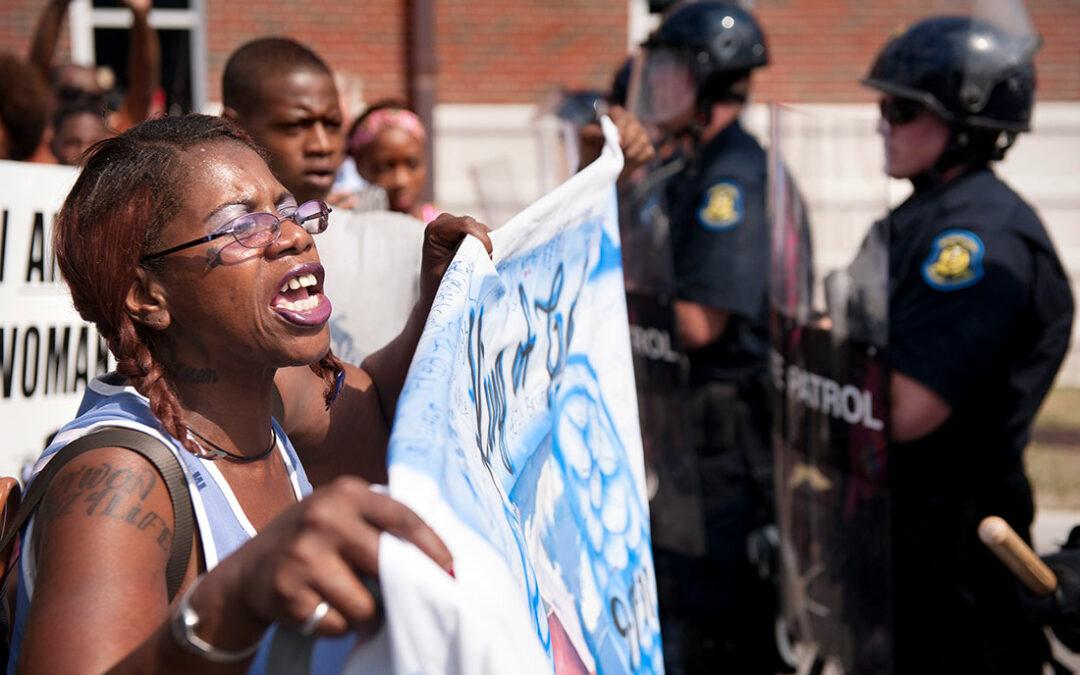Kayla Reed was born in a predominantly African American section of St. Louis where, like her own kin, many Black families had been transplanted out of the Deep South.
After the death of her grandmother, Reed moved with her father from the city to a St. Louis County town located within one mile of Ferguson, Missouri, where 10 years ago, a Black teenager’s fatal shooting by a white police officer changed Reed’s life and shook awake a nation.
“It was like in my backyard,” recalls Reed, who was not a community organizer. She was a pharmacy technician with a second job at a furniture store. Like so many others, on Aug. 9, 2014, Reed learned by word of mouth, as she clocked out of a shift, that an unarmed 18-year-old from the neighborhood had been killed.
His name was Michael Brown.
Darren Wilson, the Ferguson police officer who fatally shot Brown, had driven a police vehicle up to the teenager and his friend. The officer ordered them to get up on the sidewalk before a scuffle ensued. Although Brown was unarmed, Wilson described Brown as menacing at 6-foot-4 and claimed the teenager charged at him before he opened fire.
Some nearby residents said Brown had his hands up in surrender when he was shot.
Largely peaceful demonstrations — some blemished by vandalism, theft and arson among residents and outside opportunists — were met with violent police response. And over the next decade, the deaths of Black people at the hands of police and vigilantes would draw support, resources and democratic change to communities all over the nation. “This time,” residents vowed, things must be different.
Reed says the passage of time has proven that what began as an uprising in Ferguson has resulted in measurable change for Black Americans. Most critically, more people are politically educated and engaged with the idea that they can build communities that work for them and not simply exist in an ecosystem of systemic racism.
“What we’ve tried to show over the last 10 years is that there is no landmark piece of legislation that we’re chasing,” says Reed, who is now executive director of Action St. Louis, a Black-led political activist group that she co-founded in 2014.
“What we are chasing is the fundamental uprooting of a system rooted in anti-Blackness, rooted in the form of white supremacy that has been continuously violent for over a century to our people.”
———
The death of Michael Brown prompted an eruption of protests and gave a boost to a then-nascent Black Lives Matter movement. In subsequent years, a new generation stepped forward to pick up the work of civil rights and racial justice started by their parents and grandparents. In racial justice movements, the uprooting of white supremacy is a lesser-invoked aim — one that also demands white people reckon with their race’s complicity in generations of disadvantage faced by Black Americans and other people of color.
It’s not just BLM. Over the last decade, Indigenous people defended land and water, Latinos resisted draconian immigration detention and deportation practices, and Asian American activists pushed back on xenophobia that endangers their lives. Together these movements, benefitting from multiracial coalition-building, are changing American democracy and the broader culture, encouraging activism the world over.
Michael Brown inspired much of that. But a decade later, the future of racial justice in the United States remains in question.
“Michael Brown embodied the anger, that was so obvious and evident after decades of dismissing it, of holding it back, of telling ourselves we’re going to overcome,” says Karla Scott, a communications professor and the former African American Studies program director at St. Louis University. “It just became the moment we said, we can’t be polite anymore. He set fire to all of the anger that had been smoldering for centuries.”
The Brown case and the Ferguson uprising prompted a generation of activists in Black-led organizations to work collectively on strategy, yielding the policy platform known as “ Vision for Black Lives.” But there was also a recognition that the vision couldn’t be achieved without building a multiracial movement, says Loan Tran, national director of Rising Majority, a coalition of advocacy organizations.
“All of these struggles are interconnected,” says Tran, who uses they/them pronouns.
Instead of arguing about who is more oppressed, multiracial coalition building over the last decade has helped communities of color get clear about common problems and opportunities, Tran says. “We are interested in building powerful movements that actually change and shift the conditions.”
———
Even as Ferguson began to address issues and heal the wounds sparked by the death of Michael Brown, the deaths of Black Americans at the hands of police drew more protests and civil unrest in other cities.
The backlash to BLM and racial justice conversations was significant. Even though former President Barack Obama convened a task force in which law enforcement leaders and Ferguson protesters compiled recommendations for policing reforms, the fatal ambush of police officers in New York City and Dallas in 2014 and 2016, respectively, brought about strong condemnations of Black protesters and organizers.
Still, the list of Black citizen casualties grew until, in 2020, the deaths of George Floyd in Minneapolis and Breonna Taylor in Louisville, Kentucky sparked an unprecedented mobilization of racial justice protests and civil unrest. This time, many felt, things really would be different.
But after four years, Congress hasn’t passed legislation meant to impose national policing reforms. Earlier this month, Democratic senators reintroduced the George Floyd Justice in Policing Act that would address some activists’ demands. There were no Republican cosponsors.
In Ferguson, residents marked 10 years to the day since Brown was killed. But an afternoon protest ended with a Black Ferguson police officer hospitalized and fighting for his life after he was assaulted by participants. Community leaders cautioned police officials against reviving the us-versus-them mentality, even as they condemned the attack on the Ferguson officer.
The recent developments haven’t deterred movement stalwarts. Reed, the St. Louis area activist, rejects the premise that a decade is long enough to achieve all the aims of any racial justice movement. This is about a “lifetime of work,” she says. “When people ask what have you gotten, what have you won, I say I’m in this until we actually do live in a country … where we are not weaponizing forces to harm our people.”
“For us, it’s not from protest to policy. It’s from protest to power.”







